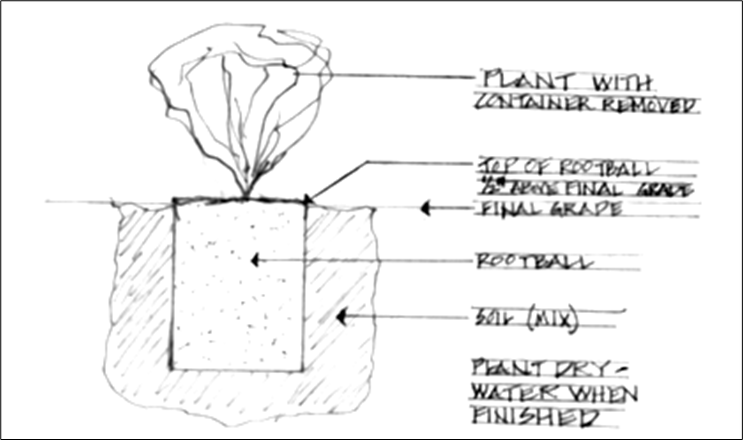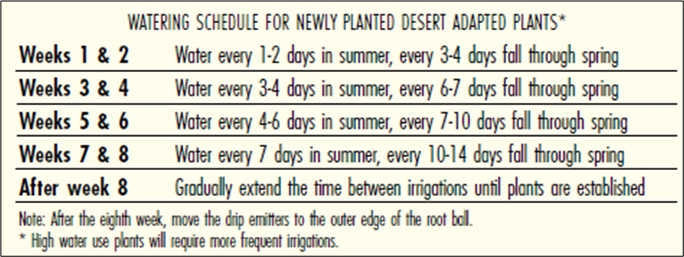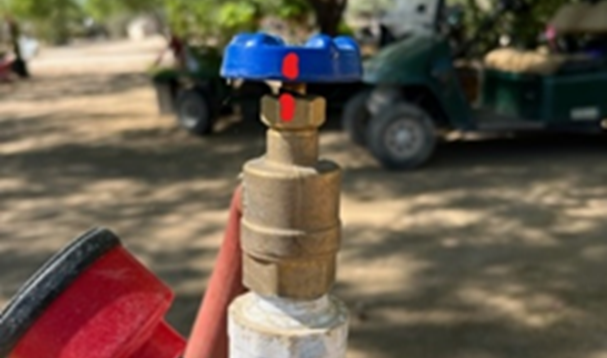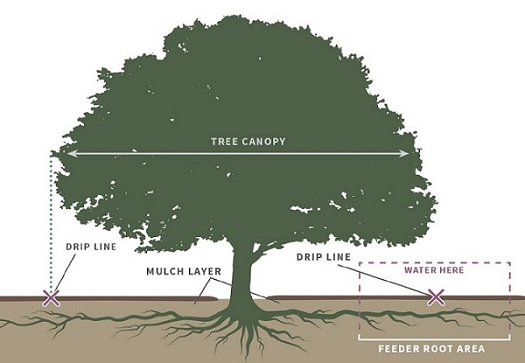Thank you for supporting your local nursery! This guide is intended to help you get your new plants off to a great start. The information provided is general in nature. If you have specific questions or concerns, please do not hesitate to ask or call (520) 299-9471.
Planting
It is very important that your new plant be planted at the proper depth. If the top of the existing root ball (from the container) is buried, it can cause the root system to suffocate. You should also keep mulch and gravel 2-6″ from plant stems. Planting too deep is the second most common reason why new plants fail. The first is improper watering.
- Dig a hole 2 times the width of the container, and as deep as the plants current root ball. If you have very poor drainage dig the hole 50% deeper.
- Mix soil amendment with existing soil (1:3, and 1:1 for fruiting or high-water plants).
- Backfill and compact some of your amendment mixture in the bottom of the hole. The new plant root ball will be ¼” to ½” above the final grade.
- Gently remove the plant from its container or cut the container away if necessary. Avoid damaging the stem or roots, and place in your hole so the plants existing root ball is ¼” to ½” above the final grade, it will sink over time.
- Backfill the sides of your hoed with amendment mixture and compact gently but firmly.
- Resist the urge to create a well. The well can degrade and soil will cover the root ball. The shallowness of the well means shallow watering. If you have a well, use the slow trickle technique (last page). Deep watering is always better.

Watering
Almost all new plants require some irrigation during the establishment period. How much and how often we water will vary depending on the plant type, plant size, sun exposure and soil type. It should also be mentioned that when we say a plant has low, medium, or high-water needs, these are meant to be relative terms and do not prescribe a specific watering schedule.
In general, the time to establish root systems of shrubs is one year and trees three years. Another general rule is how deep plants should be watered. You can test how deep you are watering by using a soil probe or pushing a stake or piece of rebar into freshly watered soil. It will stop once it hits dry soil.
- 1 foot – Cacti, annuals, small perennials
- 2 foot – Shrubs
- 3 foot – Trees
It is always best to water a larger volume of water over a period of a few hours to ensure deep watering. Roots follow water so when we deep water we encourage deep roots, and those plants will be more drought tolerant. Additionally, salts and minerals follow water so deep watering prevents salt build up in the root zones which causes leaf burn. Don’t run your irrigation every day for 15 minutes in the landscape (pots are different). This is not deep watering and will only water a few inches of soil at best.
Do not place the emitter against the main trunk/stem. New plants should be watered with drip irrigation where the soil from the container meets the native soil and amendment mixture as shown with the red arrow in Figure 1. For all new plants use the following guide to determine the volume of water needed per watering
| Container | Water volume | GPH | Run Time |
| 1 Gallon | 3 gal | 1 | 3-4 Hrs |
| 3 or 5 Gallon | 5-7 gal | 2 | 3-4 Hrs |
| 15 Gallon | 15-20 gal | 6 | 3-4 Hrs |
| 25 Gallon | 20-30 gal | 8 | 3-4 Hrs |
Cactus, yucca, and other xeric plants – New plants can be watered deeply once every 2 weeks when temperatures are >90F and once a month in the spring and fall when temps are <90F. Avoid watering December-March. In the second year you can water once a month when temperatures are >90F and only water if needed when temperatures are below 90F. Non-native species may need to be watered more frequently.
Native and arid adapted trees, shrubs, and perennials (e.g., Texas Ranger, Fairy Duster, Oleander, Mesquite) – The frequency at which you water new plants will largely depend on the time of year. The following table is a good guideline for beginning to establish these types of plants.

Moderate to high water plants (e.g., Citrus, hibiscus, crape myrtle, roses) – These plants have evolved in ecosystems that receive more rainfall than the Tucson Valley. This includes our native plants that occur in riparian areas, riverbeds, higher elevations, or other ecosystems. These plants will use the same initial volume of water (Table 1) but will be watered more frequently. A good place to start is:
| Week 1 – Everyday in summer, Every 2 days in winter |
| Week 2 – Every other day summer, Every 4 days in winter |
| Week 3 – Every 3-4 days summer, Once a week in winter |
Most moderate and high-water plants don’t want their root systems to dry out too much. As they become larger you may be able to increase the frequency between waterings, but most will do well with 2-3 times a week in summer and once a week in winter.
Dormancy and watering – Plants that are deciduous or go winter dormant do not need as much water in winter as other plants. Once they have lost all their leaves for the winter new shrubs and smaller plants can be watered every 5-7 days and every 10-14 once established
Hose watering
Hose watering is not precise and less ideal than drip irrigation. Use this method to estimate how much water you are giving plants.
- Turn the hose on so the stream is just enough to pool on the ground but not ‘run away’ or overfill your well.
- With a sharpie draw a line on the stationary part of the spigot up to the handle (Figure 2). Now you have the same rate every time.

- Time how long it takes to fill a 1gal container.
- Take that time to determine how long you need to water to get the appropriate volume on your plant.
Example: If you fill a 1gal container in 10 min that adds up to 6gal per hour (GPH). If you need 25 gallons of water then you should run for a little over 4 hours (25g/(6gal/hr) 4.2 hours.
Getting Plants Established
As your new plant grows you should do a few things to help it get established. When plants increase in size they require more water and the time between watering can be increased. The following table demonstrates the volume of water needed for different plants at different sizes. To increase the volume of water you can increase the number of emitters or increase the run time of your system.

As plants grow we also have to move the emitters further away from the trunk. The roots that absorb water and nutrients are not near the trunk of the tree. Rather they are at the edge of the canopy. This is where water should be applied and is called the drip line.

In a perfect world trees, cacti and shrubs should all be on separate valves/lines because they have different water needs. When plants with different needs have to be on the same line and schedule you will have to experiment with the watering frequency and emitters to find a balance between different requirements (e.g. enough water for your shrubs but not over water your cactus).